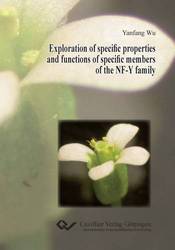| Areas | |
|---|---|
| Serie de libros (96) |
1378
|
| Nachhaltigkeit |
3
|
| Gesundheitswesen |
1
|
| Letra |
2364
|
| Ciencias Naturales |
5406
|
| Matemática | 229 |
| Informática | 319 |
| Física | 980 |
| Química | 1363 |
| Geociencias | 131 |
| Medicina humana | 243 |
| Estomatología | 10 |
| Veterinaria | 108 |
| Farmacia | 147 |
| Biología | 835 |
| Bioquímica, biología molecular, tecnología genética | 121 |
| Biofísica | 25 |
| Nutrición | 45 |
| Agricultura | 1004 |
| Silvicultura | 201 |
| Horticultura | 20 |
| Ecología y conservación de la tierra | 148 |
| Ciencias Ingeniería |
1793
|
| General |
98
|
|
Leitlinien Unfallchirurgie
5. Auflage bestellen |
|
Erweiterte Suche
Exploration of specific properties and functions of specific members of the NF-Y family (Tienda española)
Yanfang Wu (Autor)Previo
Lectura de prueba, PDF (91 KB)
Indice, PDF (52 KB)
Kurzbeschreibung
Der eukaryotische Transkriptionsfaktor nuclear factor y (NF-Y) besteht aus den Untereinheiten A, B und C und bindet an das als CCAAT-Box bekannte cis-Element. Während in Menschen und Säugern die drei Untereinheiten von jeweils nur einem Gen kodiert werden, existieren in Arabidopsis thaliana 10, 13 und 13 Gene für die NF-Y Untereinheiten A, B und C. Für einige der pflanzlichen NF-Y Untereinheiten wurden mitunter wichtige Rollen in ganz unterschiedlichen physiologischen Prozessen beschrieben. Basierend auf vorangegangenen Expressionsstudien aller NF-Y Gene in Arabidopsis thaliana, während unterschiedlicher Entwicklungsstadien und als Antwort auf verschiedene Stresssimuli, wurden bestimmte NF-Y Gene für weitergehende Untersuchungen ausgewählt. Zum Nachweis einzelner NF-Y Untereinheiten in den entsprechenden Überexpressionspflanzen als auch im Wildtyp (WT) wurden spezifische polyklonale Antikörper erzeugt. Die Zell-spezifische Expression ausgewählter NF-Y Gene wurde anhand von Promotor::GUS Konstrukten in stabil transformierten Arabidopsis-Pflanzen analysiert. Histochemische Untersuchungen zeigten eine erhöhte GUS-Expression in NF-YB3::GUSPflanzen nach Verwundung auf. Quantitative RT-PCR Experimente deuteten auf eine Beteiligung von NF-YB3 an der spezifischen Antwort auf Wundstress hin. Zur Untersuchung der Funktion von NF-Y Untereinheiten während der zellulären Antwort auf abiotischen Stress wurde ein reverse genetic Ansatz gewählt. Die loss-of function Pflanzen nf-yb3 und nfya5 zeigten jeweils eine verspätete Blütenbildung unter Langtag-Bedingungen (LD). Demzufolge spielen NF-YB3 als auch NF-YA5 eine wichtige Rolle während der photoperiodischen Blühinduktion. Darüberhinaus zeigten Transkriptanalysen eine verminderte Expression von FLOWERING LOCUS T (FT) und SUPPRESSOR OF OVEREXPRESSION OF CONSTANS1 (SOC1) in nf-yb3 und nf-ya5. Diese Ergebnisse unterstreichen das existierende Modell, dass der NF-Y Komplex mit dem CONSTANS (CO) Protein interagiert und so die Blühinduktion anhand der Expression von FT in Arabidopsis reguliert. NF-A5 spielt zusätzlich auch eine Rolle während des Wachstums und der Entwicklung von Pflanzen. 35S::NF-YA5- Pflanzen waren zwergwüchsig. Diese morphologische Veränderung von NF-YA5 überexprimierenden Pflanzen kann nicht durch die exogene Gabe von Gibberelinsäure (GA) verhindert werden. Bei genauerer Untersuchung der Anatomie zeigten 35S::NF-YA5 kleinere Blattzellen als der WT. Demzufolge spielt NFYA5 eine entscheidende Rolle während des Längenwachstums von Blattzellen.
Description
In yeast and mammals, the transcription factor nuclear factor Y (NF-Y) is composed of the subunits A, B and C and binds to the CCAAT box cis-elements. While human and animals encode the three subunits of NF-Y each in single copy gene, Arabidopsis thaliana possesses 10, 13 and 13 genes encoding the NF-Y subunits A, B and C, respectively. A few individual plant NF-Y subunits have been described to be involved in a number of important biological processes. Based on previous expression profiles of all NF-Y genes in Arabidopsis thaliana during development and in response to stress conditions, some candidate genes for NF-Y subunits were selected for detailed analysis. Specific polyclonal antibodies raised against the selected NF-Y subunit confirmed the presence of the corresponding subunit in wild-type (WT) and overexpressor plants. The selected NF-Y genes were analyzed on their cell-specific expression pattern during plant development by using promoter::GUS fusion gene constructs in stable transformed Arabidopsis plants. Histochemical analysis revealed that the GUS expression was induced in NF-YB3::GUS plants responding to wounding. Quantitative RTPCR experiments suggested that NF-YB3 is involved in wounding stress responses. A reverse genetic approach was used to examine the functions of the NF-Y subunits under abiotic stress. The loss-of function nf-yb3 and nf-ya5 plants both exhibited delayed flowering under long-day (LD) conditions. This indicates that NF-YB3 and NF-YA5 are necessary for photoperiod-dependent flowering. Transcript analysis suggested that the expression of FLOWERING LOCUS T (FT) and SUPPRESSOR OF OVEREXPRESSION OF CONSTANS1 (SOC1) was reduced in absence of NF-YB3 or NF-YA5. These results underlined the existing model, in which a NF-Y complex interacts with CONSTANS (CO) to control flowering time through regulating the expression of FT in Arabidopsis. In addition to changes in flowering time, NF-YA5 plays a role in plant growth and development. A dwarf phenotype was observed in 35S::NF-YA5 plants. These morphological alterations of NF-YA5 overexpressor plants were not rescued by the application of exogenous gibberellins (GA). The anatomical analysis revealed that the leaf cell of 35S::NF-YA5 plants was smaller than WT. This suggested that NF-YA5 plays a role in leaf cell elongation.
| ISBN-13 (Impresion) | 9783954043217 |
| ISBN-13 (E-Book) | 9783736943216 |
| Formato | A5 |
| Idioma | Inglés |
| Numero de paginas | 126 |
| Edicion | 1. Aufl. |
| Lugar de publicacion | Göttingen |
| Lugar de la disertacion | Berlin |
| Fecha de publicacion | 21.12.2012 |
| Clasificacion simple | Tesis doctoral |
| Area |
Bioquímica, biología molecular, tecnología genética
|








